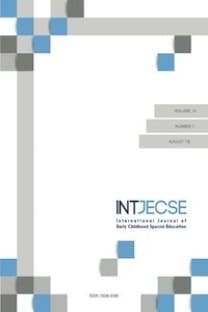Severity Levels of Autism, Social Interaction Behaviours and School Adjustment of Pre-School Children with Autism Spectrum Disorder
Öz School adjustment throughout the early years of formal schooling has been examined on scientific studies for various reasons. Because it predicts certain parts of school success in later years, school adjustment has been suggested to become a focus of research. Although there are numerous factors affecting school adjustment, these factors appear to be categorised as being related to child, family and school or programme. This study examines the relationship between the severity levels of autism in preschool children and their social interaction behaviours characteristic to autism, and their school adjustment. For this purpose, data gathered from a total of 40 students, 6 girls and 34 boys. The age range of the children was 44 to 78 months. Findings reveal that severity levels of disability and social interaction behaviours that are characteristic to ASD predict the school adjustment of preschool children with ASD by 54% in the category of Classroom Participation and by 44% negatively and significantly in the category of Positive Orientation. The findings were discussed based on the literature findings.
Anahtar Kelimeler:
School Adjustment, Preschool Period, Autism Spectrum Disorder, Social Interaction
___
Akgün Giray, D. (2015). Öğretmen adaylarınca hazırlanan ve sunulan sosyal öykülerin otizm spektrum bozukluğu olan çocukların sosyal becerileri edinmeleri üzerindeki etkisi (Unpublished Master’s Thesis). Anadolu University, Eskişehir.Aksoy, V., & Diken, İ. H. (2016). Identification of psychometric characteristics of sample of vocal behaviour and interaction assessment record forms. International Journal of Early Childhood Special Education (INT- JECSE), 8(2), 165-183. DOI: 10.20489/intjecse.284660
American Psychiatric Association (APA). (2013). Diagnostic and statistical manual of mental disorders, DSM-5,(Fifth edition). American Psychiatric Association.
Bakkaloğlu, H., & Sucuoğlu B. (2018). School adjustment of children with and without special needs in preschool classrooms. Elementary Education Online, 17(2), 580-595. Doi: 10.17051/ilkonline.2018.418906
Bart, O., Hajami, D., & Bar-Haim, Y. (2007). Predicting school adjustment from motor abilities in kindergarten. Infant and Child Development, 16, 597-615. DOI: 10.1002/icd.514
Betts, L. R., & Rotenberg, K. J. (2007). A short form of the Teacher Rating Scale of School Adjustment. Journal of Psychoeducational Assessment, 25(2),150-164. 10.1177/0734282906296406
Birch, S. H., & Ladd, G. W. (1997). The teacher-child relationship and children's early school adjustment. Journal of School Psychology, 35(1), 61-79.
Büyüköztürk, Ş. (2010). Sosyal bilimler için veri analizi el kitabı (12. Baskı). Ankara: Pegem Akademi.
Can, A. (2013). SPSS ile Bilimsel Araştırma Sürecinde Nicel Veri Analizi. Ankara: Pegem Akademi.
Cillesen, A. H. N., Haselager, G. J. T., & Lieshout, C. F. M. (1997). Early peer interaction as a predictor of later social adjustment: Results from a five-year longitudinal study. Paper presented at the Annual Meeting of the Eastern Psychological Association, Washington, DC.
Demir, Ş. (2012). Otizm Spektrum Bozukluğu Olan Çocuklara Sosyal Becerilerin Öğretimi. Elif Tekin-İftar (Ed.), Otizm Spektrum Bozukluğu Olan Çocuklar ve Eğitimleri içinde (s.369-422). Ankara: Vize Yayıncılık.
Demir, Ş. (2014). Assessing social skills of children with autism. Ankara University Journal of Faculty of Educational Sciences 47(2), 223-244.
Diken, İ. H., Ardıç, A., Diken, Ö., & Gilliam, J. E. (2012). Exploring the validity and reliability of Turkish Version of Gilliam Autism Rating Scale-2: Turkish standardization study. Eğitim ve Bilim, 166(37), 318-328.
Gay, L. R., Mills, G. E., & Airasian, P. (2006). Educational Research. NJ: Pearson, Merrill Prentice Hall.
Gülay, H. (2011). Anasınıfına devam eden 5-6 yaş grubu çocukların okula uyumlarının sosyal beceriler açısından incelenmesi. e-Journal of New World Sciences Academy Education Sciences, 6(1),139-146.
Gülay Ogelman, H., & Erten Sarıkaya, H. (2013). Okul öncesi eğitimi almış çocukların okula uyum düzeylerinin 5 ve 6 yaşta incelenmesi: İki yıllık boylamsal çalışma. International Journal of Social Science, 6(7), 417-434. DOI: http://dx.doi.org/10.9761/JASSS1658
Hausken, E. G., & Rathbun, A. H. (2002). Adjustment to kindergarten: Child, family, and kindergarten program factors. Paper presented at the Annual Meeting of the American Educational Research Association, New Orleans, LA.
Hsiao, M., Tseng, W., Huang, H., & Gau S. S. (2013). Effects of autistic traits on social and school adjustment in children and adolescents: The moderating roles of age and gender. Research in Developmental Disabilities 34, 254–265. http://dx.doi.org/10.1016/j.ridd.2012.08.001
Kaya, Ö. S., & Akgün, E. (2016). The study of school adjustment of preschool children in the point of some variables. Elementary Education Online, 15(4), 311-1324. DOI: http://dx.doi.org/10.17051/io.2016.51992
Krug, D. A., Arick, J. R., & Almond, P. J. (2008). ASIEP-3 Autism Screening Instrument for Educational Planning. Third Edition. Austin, Texas: Pro-ed.
Ladd, G. W. (1990). Having friends, keeping friends, making friends, and being liked by peers in the classroom: Predictors of children's early school adjustment? Child Development, 61, 1081-1100. http://www.jstor.org/stable/1130877
Ladd, G. W., & Price, J. M. (1987). Predicting children's social and school adjustment following the transition from preschool to kindergarten. Child Development, 58, 1168-1189. http://www.jstor.org/stable/1130613?seq=1&cid=pdf-reference#references_tab_contents
- ISSN: 1308-5581
- Başlangıç: 2009
- Yayıncı: İbrahim H. DİKEN
Sayıdaki Diğer Makaleler
The Relationship of the Type of Preschools with Child Development and Parent Involvement
Teaching Children with Intellectual Disabilities through Video Prompting: Smartphone vs. Tablet
Serife YUCESOY-OZKAN, Emrah GULBOY, Feyat KAYA
Preschool Teachers’ Use of Strategies to Support Social-Emotional Competence in Young Children
